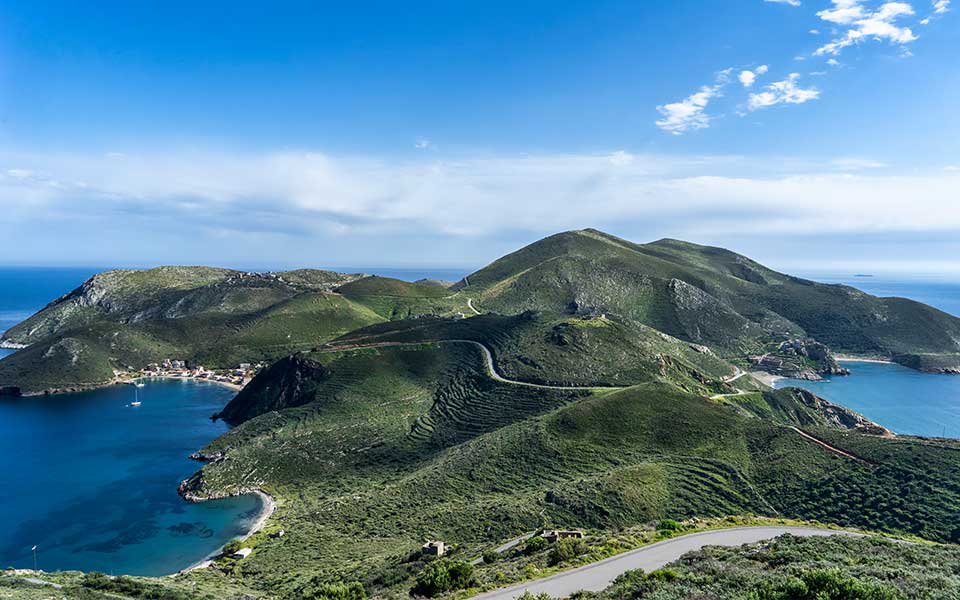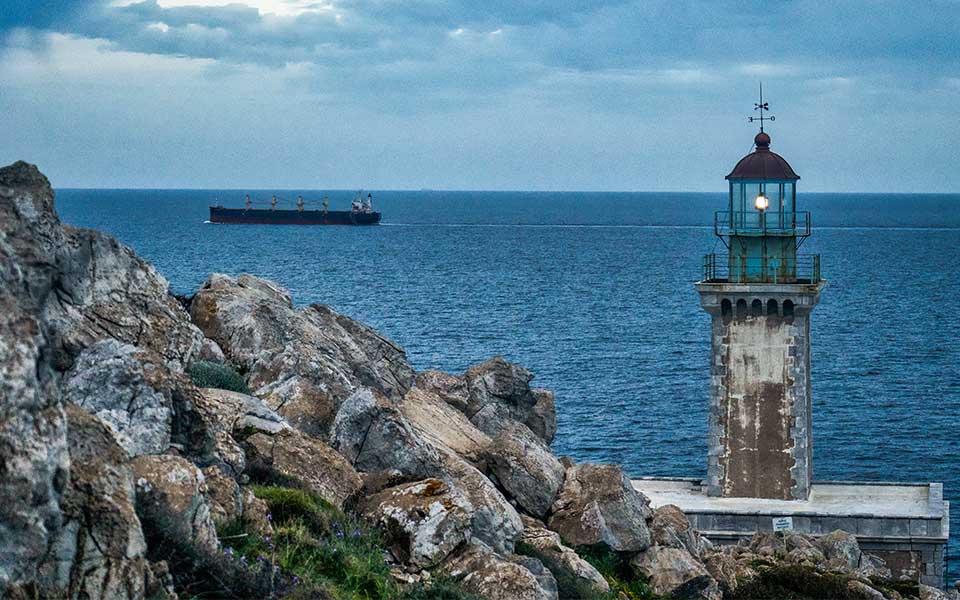Sacred Summits: Greece’s Ancient Mountain Sanctuaries
From Crete to Olympus, hike the...

Cape Tainaron - according to legend, one of the entrances to the Underworld lay here.
© Perikles Merakos
Cape Tainaron, jutting proudly into the Mediterranean at the southernmost tip of the wild and rugged Mani Peninsula, offers more than just breathtaking views. Its allure lies in its multifaceted identity—a nexus of myth, history, and strategic significance that has shaped the region and its people for millennia.
From its mythological ties to the ancient Greek Underworld to its pivotal role in naval conflicts in more recent times, Cape Tainaron, referred to in hallowed antiquity as the “edge of the Upper World,” stands as a testament to the interplay between myth and reality.
Join us as we delve into the depths of history and mythology, uncovering the secrets of this captivating corner of Greece. From the Gates of Hades to the echoes of epoch-defining naval battles, Cape Tainaron invites us on a journey through time and legend, offering a glimpse into the timeless allure of exploration and discovery.

The beach at Aria and the ruins of an ancient settlement.
© Shutterstock
In Greek mythology, Cape Tainaron, also called Cape Matapan (from the Doric Greek “Metepea Akra,” meaning “promontory between two seas”), occupies an important place as the fabled entrance to the Underworld, presided over by Hades, god of the dead. The cave at the Cape’s edge, known as the “Gates of Hades,” served as the threshold between the world of the living and the realm of the dead.
To the ancient Greeks, the kingdom of Hades was believed to be a vast domain where the souls of the deceased journeyed upon death, guided by Hermes, the messenger of the gods, to face judgement. The entrance was guarded by a terrifying multi-headed dog, the infamous Cerberus, also known as the “Hound of Hades,” who prevented the living from entering and the dead from escaping.
Within the shadowy depths of Hades lay various realms, including the Elysian Fields for the virtuous, and gloomy Tartarus for the wicked, reflecting the Greeks’ complex understanding of morality and the afterlife.
Ancient writings abound with references to this ominous portal, depicting it as a place of both dread and reverence. Pilgrims and adventurers of antiquity would journey to the extreme tip of Cape Tainaron in search of spiritual enlightenment or to pay homage to the gods of the Underworld. Over time, a cave-like temple of necromancy (“necromanteion”), or Oracle of the Dead, was established on the headland, where the ancients would perform evocation rituals to communicate with the spirits of their dead ancestors.

The beach at Porto Sternes with its very refreshing waters.
© Olga Charami

In front of the Roman mosaic, which local Maniot fishermen have dubbed the “Star of Aria.”
© Olga Charami
Today, local fishermen point to a hole in the rock on the western side of the peninsula as the fabled gateway to the Underworld. Nearby are the scattered ruins of an ancient settlement – including the knee-high floor plans of Roman villas – just up from the pebbled beach (Aria) where the fishermen moor their boats. The most striking feature here is a beautifully preserved 1st century AD Roman floor mosaic with a circular, wave-like pattern, known locally as the “Star of Aria.”
According to the 2nd century AD traveler Pausanias, the sculpted canal on the east side of Porto Sternes, which is still visible, was the course taken by the souls of the dead on their way to the Underworld, transported by the grim-faced ferryman, Charon. Greek geographer Strabo, writing in the early 1st century AD, also described a sacred grove with a nearby cave.
On the hill above the cave lie the ruins of Agion Asomaton, a Byzantine church built on or near the site of an ancient temple dated to the Classical period (5th and 4th centuries BC), dedicated to the sea god Poseidon – so-called “Poseidon Tainaros.” Archaeologists believe the materials used to build the church were recycled from the temple. During excavations, dozens of bronze votive figurines were discovered.

The Cape Tainaron (Matapan) Lighthouse
© Perikles Merakos
Cape Tainaron was also the site of the city of Taenarum, one of the oldest settlements in the region of ancient Laconia, and once a bustling hub of maritime trade and cultural exchange. The city found fame for its green marble and marine Murex snails, which yielded the prized Lacedaemonian Purple dye.
The city’s founding myth is closely tied to the legendary figure of Taenarus, a son of Zeus (or Poseidon, depending on the tradition), who is said to have established a sanctuary of Poseidon here known as the “Taenarum.” In antiquity, the temple and its associated sanctuary was known as a place of asylum for slaves. According to the Greek historian Thucydides, writing in the late 5th century BC, the temple was the site of a notorious massacre of escaped helots, agrarian slaves living under the yoke of the Spartans. The killing, which took place sometime in the mid-460s BC, was deemed unlawful and the Spartans were accursed. An earthquake that devastated Sparta in 464 BC was seen as divine retribution, sent by a vengeful Poseidon. The event led to the well-known Greek proverb “Tainarian evil.”
But Poseidon wasn’t just keeping a watchful eye over escaped slaves. The location of the temple itself, at the southerly point of the Greek mainland, commanding views of the Messenian Gulf in the west and the Laconian Gulf in the east, served as a beacon for sailors navigating the treacherous coastal waters. Ancient mariners would have routinely offered prayers and sacrifices in exchange for safe passage.
At the southernmost tip of the peninsula, at the end of a scenic hiking path, is the imposing Cape Tainaron (Matapan) Lighthouse, standing 25m above sea level. Constructed in 1882 by a team of French architects and engineers, the square-shaped lighthouse began operating in 1887 under the auspices of the Hellenic Lighthouse Services. Initially, it had a beam distance of 16 nautical miles and could illuminate up to 41m above the water, providing a vital navigational aid for passing ships. Since 1984, the lighthouse has been automated, operating a beam that covers a distance of 22 nautical miles.

Batalha Naval do Cabo Matapão, by António José Ramos, copy of the original painting made by João Dantas in 1812.
© Museu Naval, Lisboa, Portugal / Pubic domain
Beyond its mythological and cultural significance, Cape Tainaron has held strategic importance throughout history, owing to its commanding position overlooking key sailing routes. Its prominence as a maritime crossroads, offering respite and provisions to weary sailors, made it a coveted prize for rival factions seeking dominance over trade and territory. This strategic significance only grew with time, as evidenced by its role in pivotal naval conflicts that helped shaped the course of history.
One such engagement was the Battle of Matapan, which took place on July 19, 1717 during the Seventh Ottoman-Venetian War (1714-1718). The conflict pitted the Venetian Republic and her allies against the Ottoman empire in a struggle for dominance over key Mediterranean territories and trade routes.
In the battle, a Venetian-led fleet, under the command of Marcantonio Diedo, supported by a mixed squadron of allied ships from Portugal, the Papal States, and Malta, engaged a nominally larger Ottoman fleet, led by Ibrahim Pasha, in the Gulf of Laconia. Following a fierce and protracted engagement, with an unknown number of casualties, both fleets steadily withdrew.
While the battle itself was inconclusive, it nevertheless stands as a notable episode for being the last time the Turkish navy attempted to expand further westwards in the Mediterranean.

The Italian flagship Vittorio Veneto withdraws from the battle area after being torpedoed by Royal Navy aircraft.
© Ministero Della Difesa-Marina / Public domain
The Battle of Cape Matapan, which occurred during World War II, was a pivotal naval engagement fought between the British-led Allies and the Italian Regia Marina. Taking place from March 27 to 29, 1941, the battle was part of the larger conflict for control of the Mediterranean theater.
The British Royal Navy, under the command of Admiral Andrew Cunningham, with the support of Royal Australian Navy ships, intercepted a combined Italian fleet off the coast of Cape Matapan in what would be a decisive victory for the Allies.
Using intelligence obtained from decrypted Italian naval signals (Enigma) by the ingenious codebreakers at Bletchley Park, Cunningham’s fleet, including battleships, cruisers, destroyers, and the aircraft carrier HMS Formidable surprised the Italian convoy in a series of coordinated attacks. The Allied naval forces inflicted heavy damage on the Italian fleet, sinking five ships and severely damaging its flagship, the Vittorio Veneto, thus ending Mussolini’s naval operations in the eastern Mediterranean for the rest of war.

The Italian heavy cruiser Bolzano under attack by Swordfish of the Fleet Air Arm on 28th March 1941. The photograph taken from the second aircraft shows the splash of a torpedo entering the water.
© Public domain
During the three-day engagement, British aircraft also played a crucial role in locating and attacking Italian vessels, further weakening the enemy’s defenses. Despite attempts by Italian cruisers to counterattack, they were outmanoeuvred and outgunned by the British and Australian forces.
As a young naval officer, the Greek-born Prince Philip, Duke of Edinburgh (1921-2021), husband of the late Queen Elizabeth II, served with distinction aboard the Royal Navy battleship HMS Valiant during the night operation off Cape Matapan. In charge of the ship’s searchlight control, he was mentioned in dispatches for his bravery, and was later awarded the Greek War Cross.
From Crete to Olympus, hike the...
Anyone who has visited Tsintzina, the...
Professor Debby Sneed explores disability in...
Why not try a brief getaway...